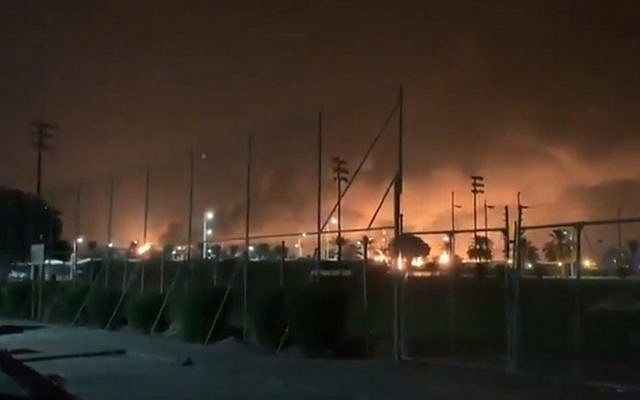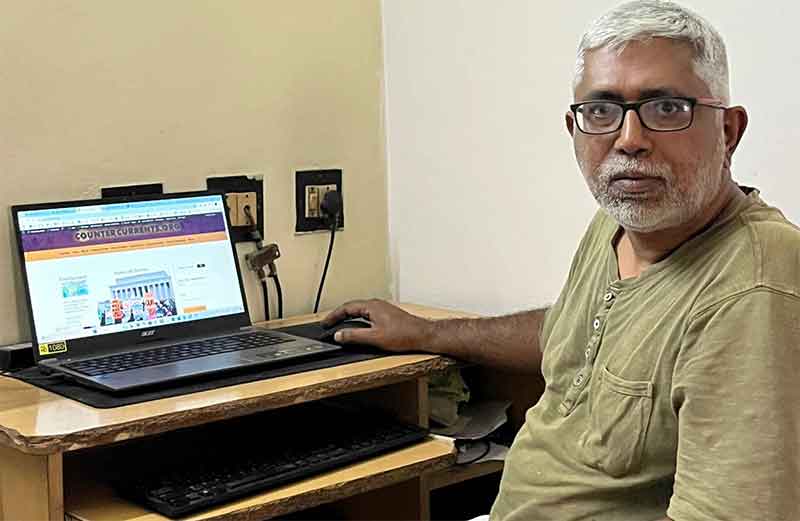
In the aftermath of Houti rebels drone attack on Saudi oil installations, President Vladimir Putin Monday offered Russian missile system to Saudi Arabia which now relies on American armaments including Patriot Missile system.
“We are ready to provide respective assistance to Saudi Arabia, and it would be enough for the political leadership of Saudi Arabia to make a wise government decision – as the leaders of Iran did in their time by purchasing S-300 and as (Turkish) President (Tayyip) Erdogan did by purchasing the latest S-400 ‘Triumph’ air defense systems from Russia,” Putin said after talks in Ankara with the Iranian President Hassan Rouhani and Turkish president Tayyab Erdogan.
These Russian weapons would protect any infrastructure facilities of Saudi Arabia, Putin added.
As Russian President Vladimir Putin meets in Ankara with the Iranian President Hassan Rouhani Monday Russia and China have called for de-escalation of tensions in the aftermath of the Drone attack on major Saudi oil installations claimed by Yemen’s Houthi rebels but blamed on Iran by the United States.
Russia has warned against a hasty reaction to the drone strikes. “We call on all countries to avoid hasty steps or conclusions that could exacerbate the situation, and on the contrary keep to a line of conduct that will help soften the impact of the situation,” Kremlin spokesman Dmitry Peskov told journalists.
Moscow also warned other countries against putting the blame on Iran for the attack and said that plans of military retaliation against Iran are unacceptable.
In a similar fashion, the China’s foreign ministry said it was “irresponsible” to blame anyone for the weekend attack on Saudi Arabia, given the absence of a conclusive investigation. Chinese Foreign Ministry spokeswoman Hua Chunying said Beijing was opposed to the intensification of any conflict. “We call on the parties concerned to avoid actions that could escalate regional tensions,” Hua said.
U.S. officials have released satellite images of the damage at Saudi Arabia’s crucial oil processing plant and a key oil field, claiming that the pattern of destruction suggested the attack on Saturday came from either Iraq or Iran.
Bernard Hudson, a former director of counterterrorism for the CIA, was quoted Monday by media as saying that the attacks probably involved a mix of drones and cruise missiles.
“It used to be that only governments had air forces, but drones have democratized violence from the sky,” said Hudson, now a fellow on gulf security issues at Harvard University. “The Houthis, with help and advice from Iran, have perfected it to a level no one else has done.”
Hudson called the counter-drone industry “exceptionally immature.” For military personnel, he said, the biggest problem is “detection at a distance. . . . If you don’t detect it until it’s on top of you, you have very little time to respond.”
Why Washington has to blame Iran over Saudi attacks?
On Monday RT published an article by Finian Cunningham, who said that US officials are blaming Iran for the devastating blitz on Saudi Arabia’s oil industry because of Washington’s spectacular failure to protect its Saudi ally.
Cunningham went on to say: “The Trump administration needs to scapegoat Iran for the latest military assault on Saudi Arabia because to acknowledge that the Houthi rebels mounted such an audacious assault on the oil kingdom’s heartland would be an admission of American inadequacy.
“Saudi Arabia has spent billions of dollars in recent years purchasing US Patriot missile defense systems and supposedly cutting-edge radar technology from the Pentagon. If the Yemeni rebels can fly combat drones up to 1,000 kilometers into Saudi territory and knock out the linchpin production sites in the kingdom’s oil industry, then that should be a matter of huge embarrassment for US “protectors.”
“American defense of Saudi Arabia is germane to their historical relationship. Saudi oil exports nominated in dollars for trade – the biggest on the planet – are vital for maintaining the petrodollar global market, which is in turn crucial for American economic power. In return, the US is obligated to be a protector of the Saudi monarchy, which comes with the lucrative added benefit of selling the kingdom weapons worth billions of dollars every year.”
Notably too, most US media reported initially that the attacks were by drones flown from Yemen, Cunningham argued and added: Associated Press reported a level of sophistication in the attacks whereby drones were used first to disable the US Patriot radar systems before other UAVs proceeded to execute the air strikes. It therefore seems that US officials are attempting to switch the story by blaming Iran. It is reckless scapegoating because the logical consequence could elicit a military attack against Iran, in which event Tehran has warned it is ready for war.
According to Cunningham, a timeline shows that the Houthis are more than capable of launching ever-more powerful ballistic missiles and deeper penetrating drones into Saudi territory. The rebels have been using drones from the beginning of the war which the US-backed Saudi-UAE coalition launched on the southern Arabian country in March 2015.
Over the past four years, the Houthi aerial firepower has gradually improved. Earlier, the Saudis, with American defense systems, were able to intercept drones and missiles from Yemen. But over the last year, the rebels have increased their success rate for hitting targets in the Saudi interior, including the capital Riyadh.
In May this year, Houthi drones hit Saudi Arabia’s crucial east-west pipeline. Then in August, drones and ballistic missiles were reported to have struck the Shaybah oil field near the border with the United Arab Emirates (UAE), as well as the Dammam exporting complex in Saudi Arabia’s Eastern Province.
The attacks on Aramco’s main crude processing facility knocked out 5.7 million barrels of daily oil production for Saudi Arabia, or more than 5% of the world’s daily crude production.
According to the New York Times, “oil prices rose about 10 percent on Monday as investors reacted to a weekend attack on one of Saudi Arabia’s most important oil facilities that could cripple petroleum exports for days or even weeks. But experts say that a severe shock to energy markets and the world economy would be unlikely.”
“The attack on the Abqaiq processing facility and another plant, deep in Saudi territory, displayed the vulnerability of the kingdom to tensions in the Persian Gulf region,” the NYT added while Eurasia Group said that Saudi Arabia’s air defense systems are designed to defend against traditional threats but are ill-equipped to tackle asymmetrical aerial threats from drones.
Abdus Sattar Ghazali is the Chief Editor of the Journal of America (www.journalofamerica.net) email: asghazali2011 (@) gmail.com
SIGN UP FOR COUNTERCURRENTS DAILY NEWS LETTER









































